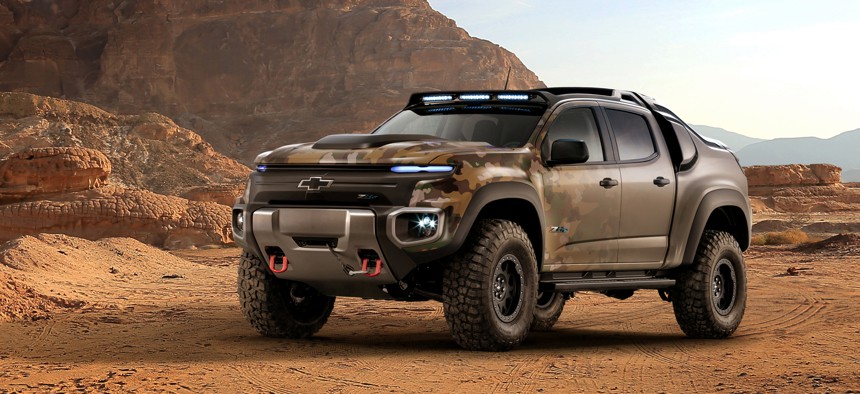
The Zh2 from GM specially designed for U.S. Army testing. GM
GM Has Built A Stealth Truck for the Army
A new hydrogen fuel cell truck could put snipers behind enemy lines, in style.
Imagine you’re a U.S. Special Forces operator on a dangerous mission. You need to hit a terrorist’s mountainside compound without the host country knowing that you’re there, so you need a ride that’s quiet and carries a low thermal signature. General Motors has a truck that they want to put you in.
The Chevrolet Colorado ZH2 is an electric truck powered by a hydrogen fuel cell that runs far quieter and cooler (between 60 to 80 degrees Celsius) than conventional automobiles. It’s almost a forward operating base unto itself, capable of producing 25 kilowatts of continuous power (and up to 50 kilowatts at peak output), along with two gallons of water per hour. The vehicle itself is a modified Chevy Colorado, rigged for off-road performance with bigger tires, better suspension, longer wheelbase, etc.
Unveiled Monday at the Association of the U.S. Army conference in Washington, D.C., the ZH2 is a technology demonstrator, so it’s not going to hit the battlefield yet.
The truck was developed in partnership with the Army’s Tank Automotive Research Development and Engineering Center, or TARDEC, which entered a unique research collaboration with GM to make sure the ZH2 could meet military requirements. TARDEC entered into a contract with GM a year ago to produce the demonstrator.
A year from contract to car is incredibly fast for the auto industry, much less for the military. But the relationship was almost four years in the making. It began when GM and TARDEC began working together Michigan in fuel cell research facilities that were about 20 minutes apart. They “provided some of their test facilities to us and integrated them into our laboratories,” said Rogers. TARDEC engineers tested the GM fuel cell stacks for performance, endurance, etc. “We are gaining access to several billion dollars of technology investment from General motors. They are gaining the value of a second party gaining evaluating and measuring data on their systems.”
In January, the Army will take possession of the vehicle and give it to soldiers to go mudding…er, put it through rigorous off-road testing, at Fort Bragg, Fort Benning, and Quantico, as well as some technical testing in Michigan. The Special Operations community will help test the vehicle, whose stealth features would be most appropriate for SOF missions, said TARDEC director Paul Rogers.
Related: Look at the Military’s New Stealth Bikes
“The ability to position yourself at a point of advantage on the battlefield, without exposing yourself, SOF definitely,” Rogers said at a preview event for the vehicle on Sunday night. “There are other reconnaissance, surveillance, target acquisition roles.”
The ZH2 “is not a combat vehicle” said Christopher Colquitt, a senior project engineer at GM who led the project. It isn’t armored and wouldn’t stand up well against an IED. “All those things would have to be considered for a combat-ready vehicle.”
GM and Army officials are optimistic that the hydrogen fuel cell system will have applications beyond a single demonstrator. But anyone who remembers learning about the Hindenburg disaster might have a few reservations about running vehicles on hydrogen, including cars.
Colquitt acknowledged the Hindenburg connection. “Hydrogen is a fuel, yes. Does it have flammable properties in certain conditions? Yes. But pure hydrogen isn’t flammable. You have to mix it with air and have an ignition source.”
The truck has three tanks of compressed hydrogen in the back of the vehicle, he said. Those tanks are composed of an inch of carbon fiber to keep the hydrogen away from fire and air.
Rogers didn’t seem concerned about the hydrogen issue, calling it an “additional area that we want to explore to make sure that there are no secondary effects for the types of threats that we deal with.”




